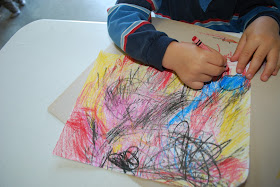Batik
Today's preschool art class was all about Batik... Well faux Batik that is. We used regular copy paper (because it crumples well), crayons, and an acrylic wash to create images that echo the technique of Batik fabric dyeing. Batik is a method (originally used in Java) of producing colored designs on textiles by dyeing them, having first applied wax to the parts to be left undyed. The wax that is placed on the textile by the artist acts as a resist and will keep the dye from penetrating that area. In some cases the wax is cracked first so that the dye seeps through the cracks forming
another layer of design for the artist.
In our version of Batik we are using crayons for the wax, crumpling the paper to "crack" the wax, and then using the acrylic wash to "dye" the image and the paint remains in the cracks creating interest.
After a little trial and error I had the kids use black crayons to make a random design on the white paper. Next we used all the colors we wanted to fill in the new spaces we made with our black crayons.
When the entire paper (or most for some kids) was filled with crayon we wadded it up, crumpled it and then flattened it back out. Finally we added the paint wash and used paper towels to carefully wipe off the excess paint.
designing
Getting started
Thinking about color!
 |
| crumpling a masterpiece! |
 |
| Adding the paint |
 |
| less crayon = more of a crackled resist painting |
 |
| Lots of crayon, look closely to see the purple cracks... |
 |
| spider! |
 |
| This image was one of my examples and was really washed out after the paint was added. 1. I would recommend darker colors for the wash, 2. as you can see I went back after it dried and used some black crayon to help the image pop back out. |


























































